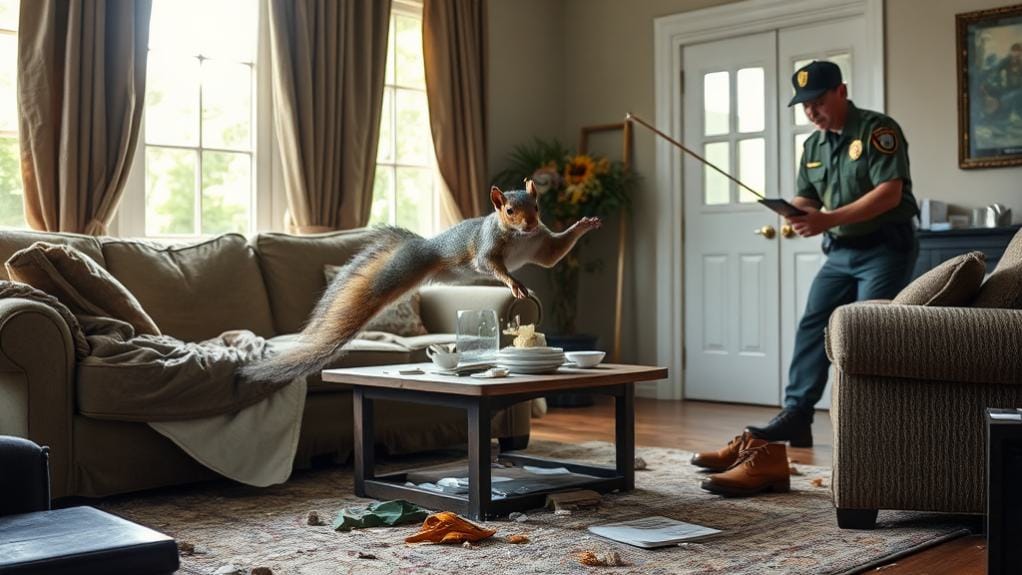Don't panic – your unwanted houseguest is more scared than you are. Start by clearing the area of pets and kids, then close interior doors to contain the squirrel to one room. Create a clear escape route by opening windows and exterior doors while removing obstacles. Avoid chasing or cornering the squirrel – that'll only make things worse. Instead, use gentle noises and bright lights to guide it toward exits. If the squirrel won't leave or shows aggressive behavior, it's time to call the pros. There's a lot more to keeping these bushy-tailed intruders out for good than just showing them the door.
Initial Safety Measures
Table of Contents
When you discover a panicked squirrel running through your home, your first priority is establishing a safe environment for both you and the animal.
You'll need to act fast but stay calm – no one needs two panicked mammals in this situation. Understanding their natural nesting behavior in trees can help you predict where they might try to hide indoors.
Start by removing all pets and children from the area. Trust me, your cat's "helpful" hunting instincts won't make this any easier.
Next, close all interior doors to confine the squirrel to one room. This isn't the time for a house-wide chase scene.
Pro Tip: Monitor the squirrel's behavior from a safe distance. If it's showing signs of aggression or extreme stress, don't play hero – call animal removal experts.
Keep your movements slow and deliberate while you identify potential escape routes.
You're going to create an exit pathway, not star in a squirrel rodeo.
Creating an Exit Path

Once you've secured the room, it's time to craft an escape route that even a panicked squirrel can't miss.
Remember, your furry friend isn't exactly thinking straight right now – they need an obvious way out. Being most active during dawn and dusk, squirrels rely heavily on clear visual cues when stressed.
Start by throwing those windows and doors wide open. You'll want multiple escape routes because, let's face it, squirrels aren't great at following directions.
Clear a path by moving furniture and clutter – this isn't the time for obstacle course training.
Pro tip: Get Fluffy and Fido out of there! Nothing makes a squirrel more nervous than your pets playing wannabe hunter.
To encourage the squirrel to exit:
- Confine it to one room by closing other doors
- Create a clear, direct path to the exits
- Make some noise – try clapping or banging pots (yes, you'll look ridiculous, but it works)
Squirrel Behavior During Panic

Inside your home, a panicked squirrel transforms into an unpredictable bundle of nerves, darting frantically from corner to corner.
You'll notice erratic movements as it desperately searches for an escape route – and trust me, your grandmother's antique vase won't stand a chance if it's in the way.
These frightened creatures often leave behind visible gnaw marks and can damage insulation while racing through your home.
Pro Tip: The more you chase it, the more damage to your home you're risking.
Here's what you're dealing with:
- Your unwanted guest is hypersensitive to noise and light
- Those scratching sounds you hear? That's your furry friend having a full-blown panic attack
- The squirrel isn't trying to attack you – it's just terrified
Keep your cool during removal efforts.
No sudden movements or loud noises (yes, that means no screaming). The calmer you stay, the easier it'll be to guide this jittery acrobat toward freedom.
Effective Containment Strategies

Before attempting to remove a panicked squirrel, you'll need to establish control over the situation through smart containment. First, seal the entry points by closing all doors except the escape route.
You'll want to remove food sources and pets from the area – trust me, your cat's "help" isn't needed right now. While humane trap options exist for squirrel removal, they're best used outdoors rather than inside your home where the animal is already distressed.
- Create a clear path to freedom by opening windows or exterior doors
- Use bright light and noise strategically to encourage the squirrel toward exits
- Keep blankets or towels handy for emergency containment if needed
Pro tip: Don't chase the squirrel around like a maniac. That'll only make things worse. Instead, work methodically to make the indoor space uncomfortable while offering an obvious escape route.
Humane traps should be your last resort – letting them leave naturally is always better.
Tools and Equipment Needed

A squirrel catcher's toolkit doesn't need to be extensive, but having the right equipment makes all the difference in safely removing your unwanted visitor.
While protective leather gloves extending to your elbow provide ideal safety, a basic set of tools will get the job done.
You'll need these essential tools for successful squirrel removal:
- A sturdy blanket or towel (because nobody wants a flying squirrel – well, you know what I mean)
- A humane live trap with bait (peanut butter works like a charm)
- Heavy-duty gloves (trust me, those tiny teeth aren't as cute up close)
- A reliable flashlight (squirrels love playing hide-and-seek in the darkest corners)
- A broom for gentle guidance (not for swatting – we're not savages)
*Pro Tip: Keep these tools in an easily accessible location. When there's a squirrel doing parkour in your living room, you won't have time for a scavenger hunt.*
Professional Help Warning Signs

Despite your best intentions to handle a squirrel situation yourself, certain warning signs clearly indicate when it's time to call in the professionals.
When you spot aggressive behavior or a cornered squirrel frantically searching for escape routes, don't play hero – that's your cue to back off and dial an expert.
- You notice signs of nesting or spot baby squirrels (Sorry, they're cute but definitely not your new roommates)
- The squirrel has caused significant damage to wiring or insulation (Unless you're also a certified electrician)
- Local wildlife regulations restrict DIY removal in your area (Yes, even that "brilliant" plan you hatched)
Post-Removal Home Inspection

Once you've successfully removed the squirrel or called in professional help, your next step involves a complete home inspection.
Don't get cocky – one evicted squirrel doesn't mean your home is fortress-worthy yet.
Your post-removal checklist needs to cover:
- Every single entry point (yes, even that tiny gap you think is "too small")
- Damage to wiring, wood, and insulation (squirrels aren't exactly gentle house guests)
- Hidden nests in your attic or walls (trust me, you'll want these gone)
- Vulnerable spots that need immediate sealing with wire mesh
Pro Tip: Don't cheap out on sealing materials. If a determined squirrel can chew through your home's structure, your dollar-store solutions won't stand a chance.
Set up regular inspections to catch new vulnerabilities before another furry invader discovers them.
Prevention beats eviction every time.
Prevention and Entry Point Sealing

The battle against squirrel invasions begins with a solid prevention strategy and meticulous entry point sealing.
You'll need to inspect around your home regularly – those crafty critters can squeeze through holes as small as 4 inches! Don't give them a chance to make your attic their new condo.
To prevent infestation and remove access points, grab your toolkit and get serious about sealing:
- Install heavy-gauge wire mesh or aluminum flashing over any suspicious openings (because squirrels aren't fans of metal buffets)
- Cut back those tree branches hanging within 6 feet of your house – they're basically squirrel highways to your roof
- Lock down your food sources in airtight containers and keep those garbage cans sealed tight
*Pro tip: Make sure everyone in your household knows the drill about outdoor cleanliness. Those scattered birdseed trails are basically "Welcome Home" signs for squirrels.*
Frequently Asked Questions
How to Make Squirrel Leave?
Create a clear exit path by opening doors and windows. You'll want to close other escape routes, make noise, use bright lights, and try unpleasant scents. If needed, set humane traps with peanut butter.
How Do You Lure a Squirrel Out?
You'll need to create an escape path with open doors and windows. Place nuts or fruit near exits, use apple cider vinegar's scent, and turn on bright lights while making noise to guide them out.
How to Chase Squirrels Away From a House?
You'll need to make your house unwelcoming by using bright lights, loud noises, and unpleasant scents. Install motion-activated sprinklers, seal entry points, and remove food sources like bird feeders from your property.
How to Get a Flying Squirrel Out of a House?
Picture a silent night scene: You'll want to open windows, dim indoor lights, and create a clear path. Use bright outdoor lights to guide the flying squirrel's exit, or set humane traps with peanut butter.
Last Word
You've just battled a frantic squirrel in your living room – and lived to tell about it. While it's tempting to laugh about your impromptu indoor wildlife safari now, don't skip the follow-up work. Check for damage, seal those entry points, and remember: squirrels aren't house guests you want to invite back. Next time you hear scratching in your walls, you'll know exactly what to do – but let's hope there isn't a next time.








